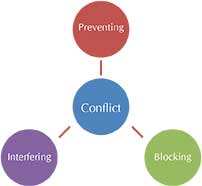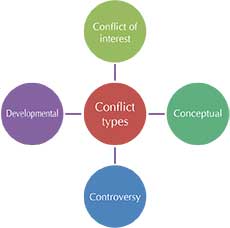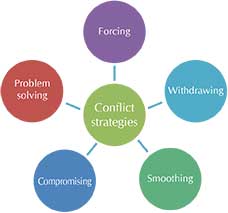Anuja Venkataraman
A teacher colleague and you have a disagreement about the sort of disciplining to be adopted in school. A student has been caught cheating on a test and while you favour conversation-based enquiry, the other teacher recommends strict measures and immediate suspension.
With both holding completely opposite stands, you and your colleague have entered into a conflict. What choices do you have in a situation like this?
There are two factors you consider when deciding what to do next and how to go about it – how much do you value your goal to ensure conversation-based enquiry process and how much do you value your relationship with your colleague? Should you submit to your colleague’s viewpoint because you are anxious to maintain a good working relationship? Should you go on an all-out war as you are convinced of the righteousness of your approach?
Understanding conflicts and the different strategies that can be adopted may guide us in the choice we need to make.
What is a conflict?
As per Johnson and Johnson, a conflict occurs when the actions of one person interfere, block, or prevent the effectiveness of the actions of another person. A conflict happens when incompatible activities occur.
Interfering: You want to participate in group work peacefully, but your group member keeps interrupting, telling his/her own story which isn’t related to the group discussion.
Blocking: You want to use a quiet room for a discussion, but others are using it and refuse to leave.
Preventing: You want to plan a party and call a colleague over, but your supervisor calls that friend on the same day for an urgent task completion.

Types of conflicts
Not all conflicts are the same. Some conflicts pertaining to choices or opinions occur within an individual, while some between individuals. Conflicts within a person are conceptual, which lead to confusion as new inputs do not cohere with the ideas or facts one already holds as true. Controversies are another form of conflict when two sides or people hold contradictory or opposite opinions about a subject, contrary values, conflicting theories or conclusions, and they seek to reach a conclusion.

A third type is developmental conflict which occurs between adolescents and adults as the children go through phases of stability and change and come into opposition with the adults.
Conflict of interest happens when the actions of a person trying to reach their goal block, interfere, or prevent the actions of another person trying to reach their goal. These conflicts are seen when people are trying to agree on something to do (what movie to see, where to eat), achieve something (money, clothes, power), use something (computer, clothes, car, etc).
What are conflict strategies?
Different people respond in different ways when faced with conflicts of interest. These responses can be classified into five different categories and are also called strategies. As per Johnson and Johnson, people generally adopt one of five strategies taking two factors into consideration.
These five strategies are forcing, compromising, withdrawing, smoothing, and problem-solving. People use these strategies depending on how eagerly they want to achieve their goals and how much or little they value their relationship with the persons they are in conflict with. This is called the dual concern model.

These strategies are learnt in childhood and become the default by force of habit. Instead of responding automatically to a conflict, we can choose how to respond. We choose the response by consciously choosing a strategy based on how important our goal is and how important our relationship with the person we are in conflict with is.
Smoothing: Smoothing is done when the goal is of no importance, but the relationship is. You smooth and fully agree to what the other person wants when he/she feels strongly and you don’t care much.
Compromise: When both the goal and the relationship are moderately important and it looks like neither can get exactly what they want, then one may sacrifice part of the relationship and give up part of the goal to be able to reach an agreement. It is used many a time when you may want to do problem solving negotiation, but don’t have time. Examples are coin tossing, sharing, coming to a 50-50 solution, etc.
Withdraw: One may withdraw and avoid the person and the issue when neither the goal is important, nor is the relationship with the person.
Problem solving: You enter problem solving negotiation when both your relationship and your goal are highly important for you. This helps to find a way to fully achieve goals and also resolve negative feelings between the two. But it requires risky moves like revealing your underlying interests, leaving you vulnerable.
Forcing/win-lose negotiation: You force or persuade the other person to your goal when your goal is very important but the relationship isn’t. You try to compete and win by entering into win-lose negotiations. Forcing includes tactics like persuading, threatening, imposing penalties, imposing deadlines, making unreasonable demands, etc.
Some of the above strategies can be done by oneself, but some require the co-operation of the other disputant too. It is useful to be competent in using every strategy and giving oneself more flexibility in choosing the appropriate one as per the perceived needs of the situation.

In conclusion
In schools, and workplaces, where we meet the same set of people with unchallenged regularity, it is a good idea to maintain constructive, amicable relationships with the people around us. Teaching the dual concern model and the five strategies, especially the details of problem-solving negotiation, can aid in establishing and maintaining an environment of trust and hope that our individual goals can be achieved by working together.
Returning to the disagreement between you and your colleague about the next steps to be taken in response to a student cheating on a test. This was a conflict of interest – as your goal to ensure a conversation-based enquiry to understand the student’s position was getting blocked by your colleague’s goal to maintain discipline and uphold rules by suspending the student.
You could decide to handle this conflict of interest using any of the five strategies, viz. compromise, smoothing, withdrawing, win-lose negotiation or forcing, and problem-solving negotiation. Conflict strategies keeping the dual concern of goal and relationship offer choices and a way to think when making life’s small and big decisions.
If your goal to understand the student’s position wasn’t very important, but keeping the relationship with your colleague was, then you could smoothen your way through the conflict by sacrificing your position and agree to their suggestion to suspend the student.
If you didn’t care about maintaining an amicable relationship, but recognized that understanding the student’s viewpoint was very important then you could force the colleague through persuasion, coercion, arguments, pressurizing and getting your way.
If you cared a bit about your relationship, but also a bit of your goal to ensure the student’s position was understood, you could consider compromising and suggest each give up on a part of their goal. For example, you could agree to have a meeting with the student, but also suspend him for a lesser time period.
If you neither cared about your relationship nor your goal, you could withdraw from the conflict entirely. You could stop pushing for the conversation-based approach and start ignoring your colleague when they spoke on this or any other issue. That wouldn’t help your cause and your relationship will also suffer negatively.
If you want both – a hearing to understand the student’s position and maintain an amicable relationship with your colleague, whom you value a lot, you could consider negotiating. Negotiating involves initiating problem solving to find an agreement that works well for both and takes care of the needs and goals of both. It would involve being transparent about what you want, your feelings, the reasons for them, understanding the other’s perspective, and together thinking of different solutions and finally agreeing on one. Once you both understand each other’s positions better, you could surprise yourselves with a solution you never imagined when you began the process.
The choice is yours and it comes with the knowledge of what you could potentially gain or lose with each chosen strategy.
What would you do in the above situation and which strategy are you most likely to use?
The author is a research associate at Azim Premji University, working with the interest group on fraternity, dialogue and justice. She hopes to work to create humane, dialogic environments in schools and classrooms that help navigate life and its inevitable conflicts better. She has worked as a facilitator in alternative schools in Bangalore, after which she pursued her Masters of Arts in Education from Azim Premji University, which serendipitously brought her to the interest group. She can be reached at anuja.venkataraman@apu.edu.in.
